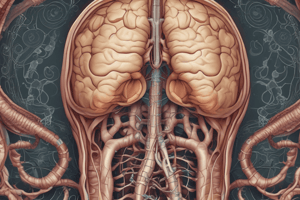Podcast
Questions and Answers
Name the organ responsible for storing bile and producing bile salts.
Name the organ responsible for storing bile and producing bile salts.
Liver
What is the primary site for nutrient absorption in the digestive system?
What is the primary site for nutrient absorption in the digestive system?
Small intestine
Describe the role of the pancreas in the digestive process.
Describe the role of the pancreas in the digestive process.
The pancreas secretes enzymes into the small intestine to aid in the digestion of proteins, fats, and carbohydrates.
What is the function of the gallbladder in the digestive system?
What is the function of the gallbladder in the digestive system?
Define the process of absorption in the digestive system.
Define the process of absorption in the digestive system.
Which digestive organ is responsible for the formation of feces?
Which digestive organ is responsible for the formation of feces?
What is the main function of the stomach in the digestive system?
What is the main function of the stomach in the digestive system?
Which organ in the digestive system is responsible for transporting food from the mouth to the stomach?
Which organ in the digestive system is responsible for transporting food from the mouth to the stomach?
Where does the majority of nutrient absorption occur in the digestive tract?
Where does the majority of nutrient absorption occur in the digestive tract?
What are the two vital organs, other than the alimentary canal, that are part of the digestive system?
What are the two vital organs, other than the alimentary canal, that are part of the digestive system?
Study Notes
The Digestive System: An In-Depth Look at the Organ Systems
The digestive system is a complex network of organs that work together to break down food into small molecules for absorption, provide the body with essential nutrients, and eliminate waste. This system is crucial for maintaining the overall health and well-being of an individual. In this article, we will discuss the digestive system, its organs, the digestive process, nutrient absorption, and the functions of the digestive system.
Digestive System Organs
The digestive system is composed of the alimentary canal, which includes the mouth, esophagus, stomach, small intestine, large intestine, and anus, as well as other vital organs such as the liver, pancreas, and gallbladder.
Alimentary Canal
- Mouth: The mouth is the point of entry for food. It contains teeth and salivary glands that begin the process of digestion.
- Esophagus: A muscular tube that connects the mouth to the stomach, and is responsible for transporting food from the mouth to the stomach.
- Stomach: A sac-like organ that uses acid and enzymes to break down food into smaller particles.
- Small Intestine: The longest part of the digestive tract, where the majority of nutrient absorption occurs through a process called diffusion.
- Large Intestine: The last part of the digestive tract, responsible for water and electrolyte absorption, and the formation of feces.
- Anus: The final exit point for waste products, through which feces are expelled from the body.
Other Organs
- Liver: An essential organ involved in processing nutrients absorbed from the small intestine, as well as storing bile and producing bile salts.
- Pancreas: A gland that secretes enzymes into the small intestine to aid in the digestion of proteins, fats, and carbohydrates.
- Gallbladder: A small sac that stores bile produced by the liver, which assists in the digestion of fats and some vitamins.
Digestive Process
The digestive process begins with the first bite and continues through the passage of food through the digestive system. The process involves the following steps:
- Chewing: Food is broken down into smaller pieces by the teeth, which initiates the digestive process.
- Swallowing: The food is pushed down the esophagus and into the stomach.
- Digestion in the stomach: The stomach secretes gastric juices, which contain hydrochloric acid and digestive enzymes, to break down food further.
- Passage to the small intestine: The partially digested food enters the small intestine, where the majority of nutrient absorption occurs.
- Digestion in the small intestine: The pancreas and liver secrete additional digestive juices into the small intestine, which further break down the food.
- Absorption: The nutrients are absorbed into the bloodstream and carried to the liver.
- Passage to the large intestine: The remaining undigested food enters the large intestine.
- Absorption of water and electrolytes: The large intestine absorbs water and electrolytes, forming stool.
- Elimination: The stool is stored in the rectum and eliminated through the anus.
Nutrient Absorption
The small intestine is the primary site for nutrient absorption. Nutrients are absorbed through a process called diffusion, where they move from a region of high concentration (inside the intestinal cells) to a region of low concentration (the bloodstream).
Functions of the Digestive System
The primary functions of the digestive system are:
- Digestion: The breakdown of food into smaller molecules for absorption.
- Absorption: The process by which nutrients from the food are absorbed into the bloodstream.
- Elimination: The elimination of waste products from the body in the form of feces.
In conclusion, the digestive system is a complex and essential organ system that plays a vital role in the health and well-being of individuals. It is responsible for breaking down food into smaller molecules for absorption, providing the body with essential nutrients, and eliminating waste. Understanding the digestive system and its functions can help individuals make informed decisions about their diet and overall health.
Studying That Suits You
Use AI to generate personalized quizzes and flashcards to suit your learning preferences.
Description
Test your knowledge on the anatomy and functions of the digestive system with this quiz. Explore the organs of the digestive system, the digestive process, nutrient absorption, and the primary functions of this essential system.




